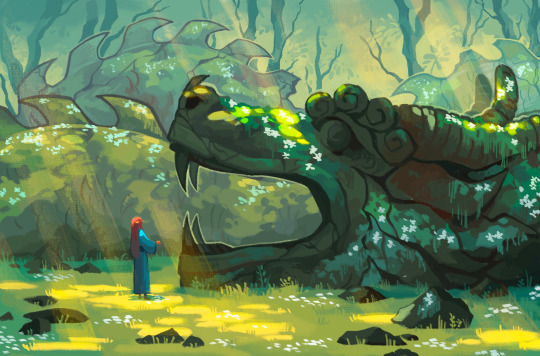#Holocene
Text


Another Saturday another formation stream!
This time we visited the subfossil wonders of Madagascar!
#sciart#paleoart#paleostream#holocene#pleistocene#madagascar#elephant birds#aepyornis#lemurs#crocodile#megaladapis#tortoise#fossils
413 notes
·
View notes
Text
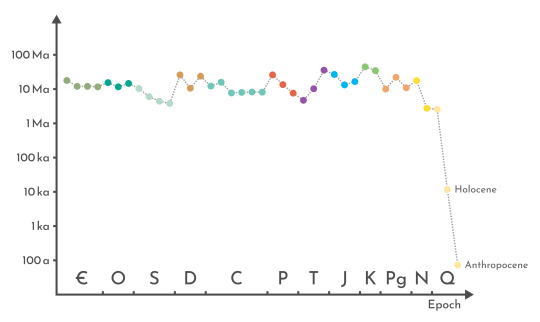
ICS time bias in one picture
829 notes
·
View notes
Text
Rufiphonia Vázquez-López & Hernández-Baños, 2024 (new genus)

(A male individual of Rufiphonia rufiventris, photographed by Hector Bottai, under CC BY-SA 4.0)
Meaning of name: Not explained by authors, but presumably Rufiphonia = rufous [in Latin] Euphonia [genus of finches including the white-vented euphonia]
Species included: R. rufiventris (rufous-bellied euphonia, type species, previously in Euphonia), R. anneae (tawny-capped euphonia, previously in Euphonia), R. cayennensis (golden-sided euphonia, previously in Euphonia), R. fulvicrissa (fulvous-vented euphonia, previously in Euphonia), R. gouldi (olive-backed euphonia, previously in Euphonia), R. imitans (spot-crowned euphonia, previously in Euphonia), R. mesochrysa (bronze-green euphonia, previously in Euphonia), R. pectoralis (chestnut-bellied euphonia, previously in Euphonia), and R. xanthogaster (orange-bellied euphonia, previously in Euphonia)
Age: Holocene (Meghalayan), extant
Where found: Humid forests in Central and South America
Notes: Rufiphonia is a genus of euphonias, a group of finches from the tropical Americas in which the males tend to be brightly colored. Unlike most other finches, euphonias feed primarily on fruits instead of seeds, and accordingly they generally have less robust beaks than typical finches.
Currently, only two euphonia genera are recognized, Chlorophonia and Euphonia, each containing a large number of species. However, a new study on the evolutionary history of this group suggests splitting Chlorophonia into two distinct genera and Euphonia into three based on their phylogenetic relationships and anatomical differences. For species traditionally classified in Euphonia, the authors propose limiting Euphonia proper to a group of closely related euphonias in which males tend to have a dark blue throat and yellow belly, resurrecting the old name Phonasca for a second group in which males tend to have a yellow throat, and coining the new name Rufiphonia for a third in which both males and females can have rufous patches on the belly, head, or underside of the tail.
Reference: Vázquez-López, M., S.M. Ramírez-Barrera, A.K. Terrones-Ramírez, S.M. Robles-Bello, A. Nieto-Montes de Oca, K. Ruegg, and B.E. Hernández-Baños. 2024. Biogeographic factors contributing to the diversification of Euphoniinae (Aves, Passeriformes, Fringillidae): a phylogenetic and ancestral areas analysis. ZooKeys 1188: 169–195. doi: 10.3897/zookeys.1188.107047
178 notes
·
View notes
Video
The only known footage of the Laysan ʻapapane (Himatione fraithii) from 1923.
After rabbits were introduced and consumed their nectar sources, the Laysan ‘apapane went extinct alongside the Laysan millerbird and Laysan rail due to a strong storm that hit the island.
[video source]
2K notes
·
View notes
Text
375 notes
·
View notes
Text

Day 24: Parocnus browni
A Pygmy ground sloth from Cuba and Hispaniola of Pleistocene and Holocene, is sleepy on a half fallen palm tree in a dense jungle of Cuba.
46 notes
·
View notes
Photo
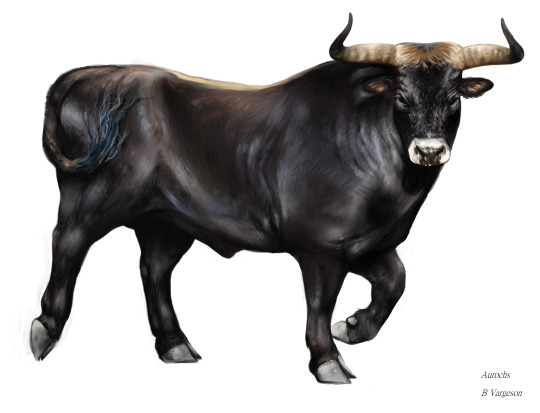
It’s been a while!!
Here’s an Aurochs illustration I’ve nearly finished as part of a local project... this has taken a while too. I’ve been busy being a mum.
434 notes
·
View notes
Text
32 notes
·
View notes
Text

Fossil Novembirb: Day 30
Three taxidermied Carolina parakeets in a row
48 notes
·
View notes
Text
The Mun Alligator
Somehow 2023 felt like a slow year for new croc taxa, but I'm happy to report that a new one just dropped yesterday.
This new crocodilian is a member of the genus Alligator, which today only includes two living species, the American Alligator and the Chinese Alligator. This new species, Alligator munensis, lived during the Quaternary in what is now Thailand and may be an important species for understanding Asian alligators.
Art by Márton Szabó and size chart by yours truly


Before we go into the mystery of the Asian alligators and their origin, lets just take a moment to appreciate how weird this guy is. The skull is very short and very deep (altirostral), it was obviously small like its modern relative the Chinese Alligator and its nostrils were weirdly pulled back, with a huge bony element separating them externally. The later looks especially weird when you know alligator skulls, where the nasals do extend over the nares, but never this much. For comparisson, below is an image of the Mun Alligator in a, Chinese Alligator in e and American Alligator in i, as well as a close up.


As you can see in the close up, the skull was also adorned by various ridges, both across the snout and the skulltable. Now the ridges beofre the eyes aren't unique to Alligator munensis, but I still want to highlight them as they are called spectacles. Just think that's something people should know (it's also what gives Spectacled Caimans their name).
What is sadly missing is the dentition, the teeth. This of course leaves out a big indicator of the diet. Which all in all leaves the ecology a bit unknown (we don't know why it has those weird nostrils either). However, Darlim and colleagues still found some clues. Notably, the tooth sockets in the back of the jaw are enlarged, something that's usually seen with globular teeth or teeth that are blunt and sideways flattened. Alligators actually derive from ancestors with globular teeth, which then became more generalized. Well, Alligator munensis may have done another switcheroo and gone back to that. Combining globular teeth with strong jaw muscles (check) and robust skulls (double check) could indicate that it could have fed on hard-shelled prey items. Now this doesn't mean it was specialised per say. Big turtles have big heads and do seasonally feed on snails, but are otherwise omnivores. Multiple alligatorids on the other hand lack globular teeth, but that doesn't stop them from taking hard-shelled prey regardless.
Images showing Caimans feeding on apple snails by Paul Williams and the BBC as well as an American Alligator eating a turtle by Okreb.



Now to discuss the history of Asian alligator species. It does seem rather strange that all extant alligatorids are from the Americas with the exception of the Chinese Alligator and it has been a long mystery how and when they got there. This isn't helped by the fact that alligator fossils from Asia are very much understudied. The Mun Alligator however shows what is to be expected, that diversity was a lot higher in prehistory than it is today. And it wasn't even that long ago, with the deposits dating to the Pleistocene or maybe even Holocene.
However, it doesn not solve the mystery entirely. While both the Chinese Alligator and the Mun Alligator are thought to be closely related, they are not ancestor and descendent. Instead, they seem to have diverged quite some time ago and evolved isolated from one another. That is still an interesting thought tho.
Darlim and colleagues suggest that this could all date back to the Miocene, when the ancestor of these two species inhabited the wetlands of eastern Asia. When plate tectonics caused the Himalayas to form and the Tibetan Plateau to be lifted up, both appear to have been split into distinct river systems. The ancestor of the Chinese Alligator into the Xi and Yangtze river systems and the Mun Alligator into the Mekong and Chao Phraya river systems.
Based on this hypothesis, and figures by Iijima, Takahashi, & Kobayashi (2016) chronicling the fossil record and distribution of Chinese Alligators, I put together this handy-dandy map that should illustrate the whole affair. Red for A. sinensis, purple for A. munensis. The red and transparent red areas are the formers current and former range, whereas squares represent fossil discoveries.

For any wanting to look deeper, there is of course the Wikipedia page Alligator munensis - Wikipedia or the paper, which is open access.
An extinct deep-snouted Alligator species from the Quaternary of Thailand and comments on the evolution of crushing dentition in alligatorids | Scientific Reports (nature.com)
#paleontology#crocodile#palaeoblr#prehistory#croc#long post#alligator#alligator munensis#chinese alligator#mun alligator#pleistocene#holocene#asia#fossils#crocodilia#alligatoridae#science
64 notes
·
View notes
Text

Otus frutuosoi
Сан-Мігельська сова (Otus frutuosoi) — невелика вимерла сова, яка колись мешкала на острові Сан-Мігель, що на Макаронезькому архіпелазі Азорських островів, у північній частині Атлантичного океану.
Повний текст на сайті "Вимерлий світ":
https://extinctworld.in.ua/otus-frutuosoi/
#otus#owl#birds#san miguel#strigidae#azores#owls#aves#holocene#paleontology#paleoart#prehistoric#bird#illustration#palaeoblr#sciart#extinct#fossils#ukraine#ukrainian#digital art#article#палеоарт#палеонтологія#україна#мова#українська мова#арт#птахи#atlantic ocean
29 notes
·
View notes
Text
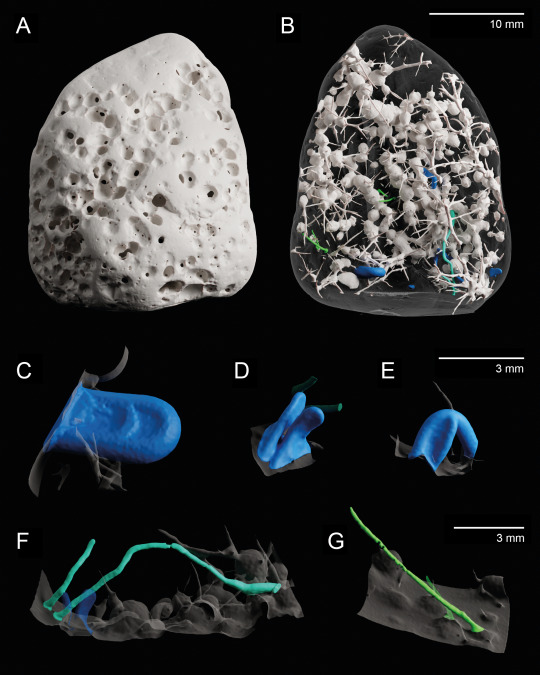
X-ray microtomography 3D model of a bioeroded limestone pebble given to me by a friend who wanted to know what the holes were. Not technically art but I think it looks cool.
I identified 4 distinct types of borings (ichnotaxa) in this 3-cm pebble:
Entobia cf. cretacea (white): typical sponge borings, composed of interconnected chambers and exploratory threads; by far the dominant ichnotaxon in the sample (97% of bioeroded volume).
Caulostrepsis taeniola (blue): U-shaped borings made by polychaete worms (e.g. spionids).
Unnamed Caulostrepsis ichnospecies (cyan): long and tightly U-shaped borings, possibly also made by polychaete worms.
Trypanites solitarius (green): simple unbranched borings that can be produced by many different organisms (polychaetes, bryozoans, phoronids).
(A-B) Full sample. (A) External view. (B) Virtual mould of the borings. (C-G) Virtual moulds of individual borings. (C-E) Caulostrepsis taeniola (note the variability in size). (F) Caulostrepsis unnamed ichnospecies. (G) Trypanites solitarius.
Experiments with limestone bricks show that bioerosion comparable in nature and extent to the one showcased here can develop after 3-4 years (Färber et al. 2016), providing a rough estimate of the time elapsed between this rock fragment first being exposed and it washing onto the shore where my friend picked it up.
References:
Bromley, R. G. (1972). On some ichnotaxa in hard substrates, with a redefinition of Trypanites Mägdefrau. Paläontologische Zeitschrift, 46(1), 93–98. https://doi.org/10.1007/BF02989555
Bromley, R. G. (2004). A Stratigraphy of Marine Bioerosion. Geological Society, London, Special Publications, 228, 455–479. https://doi.org/10.1144/GSL.SP.2004.228.01.20
Bromley, R. G., & D’Alessandro, A. (1983). Bioerosion in the Pleistocene of Southern Italy: Ichnogenera Caulostrepsis and Maeandropolydora. Rivista Italiana Di Paleontologia e Stratigrafia, 89(2), Article 2.
Bromley, R. G., & D’Alessandro, A. (1984). The ichnogenus Entobia from the Miocene, Pliocene and Pleistocene of southern Italy. Rivista Italiana Di Paleontologia e Stratigrafia, 90(2), Article 2.
Färber, C., Titschack, J., Schoenberg, C., Ehrig, K., Boos, K., Baum, D., Illerhaus, B., Asgaard, U., Bromley, R., Freiwald, A., & Wisshak, M. (2016). Long-term macrobioerosion in the Mediterranean Sea assessed by micro-computed tomography. Biogeosciences, 13, 3461–3474. https://doi.org/10.5194/bg-13-3461-2016
#entobia#caulostrepsis#trypanites#sponge#polychaete#bioerosion#trace fossil#holocene#ichnology#ichnotaxonomy#paleontology#geology#tomography#microtomography
110 notes
·
View notes
Text
Quechuavis van Els et al., 2023 (new genus)
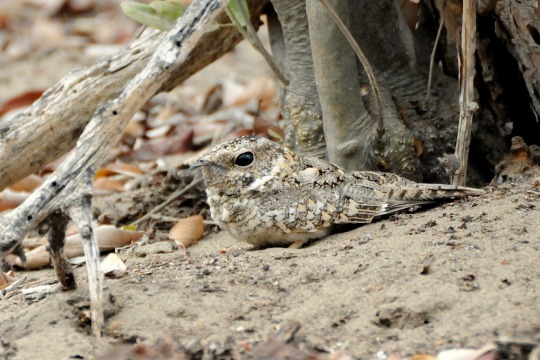
(An individual of Quechuavis decussata, photographed by christian_nunes, under CC BY-NC 4.0)
Meaning of name: Quechuavis = Quechua bird [in Latin]
Species included: Q. decussata (Tschudi's nightjar, type species, previously in Systellura)
Age: Holocene (Meghalayan), extant
Where found: Arid, open habitats in western Peru and northern Chile
Notes: Quechuavis decussata is a nightjar, a group of nocturnal, insect-eating birds. Nightjars typically spend the day camouflaged against the ground and use their wide mouths to capture flying insects at night. The Tschudi's nightjar was formerly considered a subspecies of the band-winged nightjar (Systellura longirostris), and even after being recognized as a separate species, has generally still been classified in the genus Systellura. However, genetic studies have shown that it is not closely related to members of the genus Systellura, nor does it appear to have any particularly close relatives among other South American nightjars. As a result, a new study reassigns the Tschudi's nightjar to a unique new genus.
Reference: Costa, T.V.V., P. van Els, M.J. Braun, B.M. Whitney, N. Cleere, S. Sigurðsson, and L.F. Silveira. 2023. Systematic revision and generic classification of a clade of New World nightjars (Caprimulgidae), with descriptions of new genera from South America. Avian Systematics 1: 55–99.
242 notes
·
View notes
Photo


Entering the Holocene: The end of a ice age in Europe, 18,000-5,000 BC
Climate changes
Around 18,000 BCE, the planet begins to warm. With the end of the last glaciation (10,000 BC), the so-called Holocene period begins. The climate is changing in all regions of the world, causing upheaval. In Europe, the melting of the ice gives access to new territories in the north. But this melting also causes a rise in sea level, engulfing formerly inhabited territories. In the Sahara, the different stages of warming initially led to a greener landscape, with large lakes, rivers and springs attracting flora and fauna. The African monsoon was then stronger than today. And the region would also have benefited from Mediterranean rains. This African humid period lasted from around 9000 to 3000 BCE. Then temperature changes in the Northern Hemisphere triggered rapid aridification of the Sahara.
by @LegendesCarto
129 notes
·
View notes

